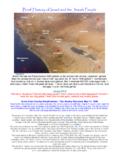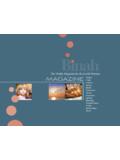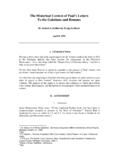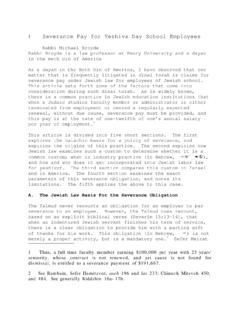Transcription of Evidence of early gene flow between Ashkenazi Jews and …
1 Journal of Genetic Genealogy 8(1):21-34, 201621 Abstract To investigate European introgression into Ashkenazi Jewry, the European-dominant haplogroup H mi-tochondrial DNA was examined. The results provided genetic Evidence that gene flow between jewish and non- jewish populations occurred early in jewish settlement in Europe with isolation of the groups thereafter. We targeted branch H7 and found three Ashkenazi jewish clades, two that were not previ-ously recognized as jewish (H7e, H7c2) and one newly identified group (tentatively H7j) characterized by 1700C and 152C transitions. A total of 100 new complete mitochondrial DNA sequences (mitogenomes) are reported, including the largest collection of H7e to date. H7e is a deeply nested clade with several subclades; more than 85% of the carriers had Ashkenazi maternal ancestry from such diverse areas as Germany and Austria in Western Europe, Poland, and the Baltic states in Central Europe, and Moldova, Ukraine and Belarus in Eastern Europe.
2 between 10% and 15% of the carriers had European non- jewish ancestry which, strikingly, showed the greatest number of mutational differences from ancestral H7e. Moreover, there was no overlap with the jewish -affiliated sequences other than at the ancestral node. Earlier research proposing early mixing followed by isolation has relied on less direct inferences. The smaller groups of H7c2 and H7j were exclusively Ashkenazi jewish , with interesting sequence patterns. H7c2 consisted of a number of non-nested sister branches, reflecting recent expansion in a large popula-tion, while H7j showed a possible in-progress vanishing of the ancestral group, well on its way to moth-ering an orphan node. The severe bottleneck and subsequent population explosion in the Ashkenazim provide a unique opportunity to view haplogroups in all states of evolution and provide a window into the Mediterranean Hellenistic world of of early gene flow between Ashkenazi Jews and non- jewish Europeans in mitochondrial DNA haplogroup H7 Doron Yacobi & Felice L Bedford, for correspondence: University of Arizona, Box 210068, Tucson, AZ 85721, USAI ntroductionOver the last decade, Evidence has accumulated that the genetic make-up of Ashkenazi Jewry is a combination of Levantine and European sources.
3 Analyses of autosomal genes, reflecting a combi-nation of paternal and maternal inheritance, have indicated a significant degree of European admix-ture among Ashkenazi Jews as well as a close re-lationship between most contemporary Jews and non- jewish populations from the Levant (Atzmon et al., 2010; Behar et al., 2010). The source of the European contribution may come from the mater-nal line. Costa and colleagues (2013) argued that the majority of the Ashkenazi mitochondrial hap-logroups, which are inherited only from the moth-er, were present in Europe long before the arrival of Jews. However, Behar and colleagues (2006) suggested that these same maternal haplogroups most likely originated in the Levant alongside pa-ternally inherited Y chromosomes of Levantine or-igin (Atzmon et al., 2010; Ostrer & Skorecki, 2013).When haplogroups have a notable presence in both the Near East and Europe, determining their geographic origins can be challenging and lead to differing interpretations.
4 An example involves T2e, a haplogroup that harbors a couple of unique Jew-ish clades. Bedford (2012) reported prevalence of T2e in Italy, Egypt, and parts of Saudi Arabia and favored a Near Eastern rather than European ori-gin of the mutations that define T2e but left open the possibility that either locale could be the origin or recipient of migration. On the other hand, Pala et al. (2012), using similar geographic incidences, concluded that T2e s origin was European. In principle, estimates of when mutations emerged can help resolve where they emerged. In practice, however, standard deviations of time estimates can extend across greater than a thousand years, and time estimates themselves can differ by an order of magnitude depending on the estimated mutation rate. In research on jewish groups, we (Bedford et al., 2013; Bedford & Yacobi, 2014) re-ported on a Bulgarian Sephardic founding lineage (T2e1b), originally identified by Behar, which we found among both Ashkenazi and Sephardic Jews from diverse regions.
5 Full genomic sequencing found much coding-region variability, with several haplotypes. Coalescence time for the sequences using a common mutation-rate estimate suggest-ed that the shared mutation (9181G) predated the split between the jewish groups and therefore likely arose in the Levant. However, a different , also justifiable mutation rate suggested the origin was much more recent, implicating geneflow in Europe after the split as the source as of the mu-tation common to both Sephardic and Ashkenazi in distinguishing between Levantine and European sources for Ashkenazi mitochon-drial haplogroups is further muddled by an often overlooked historical fact: that the boundaries of Europe and the Levant are a relatively recent his-torical construct dating back to the Arab conquest in the 7th century CE. To further investigate the role of European ma-ternal admixture into the Ashkenazi gene pool, we took a different approach than previous in-vestigations.
6 Rather than surveying a large num-ber of haplogroups with ambiguous geographic origins, we conducted a detailed investigation into a haplogroup that is overwhelmingly Euro-pean ( , Brotherton et al., 2013) yet still found among modern Ashkenazi Jews. Haplogroup H is the dominant European mtDNA haplogroup. Its numerical success nears half the population in some countries, making it the most common haplogroup in Europe. Among Ashkenazi Jews, 23% have haplogroup H (Costa et al., 2013), yet despite being a major Ashkenazi haplogroup, it is often overlooked. When examining Ashkenazi H mitogenomes, Costa and colleagues found that most of them nest within west/central European subclades, with closely matching sequences in Eastern Europe. As such, haplogroup H s gener-al European dominance may illuminate issues of introgression of European DNA into the Ashke-nazi gene pool.
7 Does haplogroup H reflect recent unions of non- jewish women and Ashkenazi men, or does it point to events of more distant interest? We focused on H7. While other choices were pos-sible, we selected H7 as an understudied clade within haplogroup H that our pilot study suggest-ed had an unexpected notable presence among the Ashkenazim. Finally, we also delved into Med-iterranean and jewish history to place the genetic results within their correct historical framework. A consideration of relevant Mediterranean and jewish history is given in Appendix A. The combi-nation of genetic results and accepted history may lead to a greater understanding of jewish mater-nal and MethodsTo identify Ashkenazi clusters within haplogroup H7, we initially selected two individuals with self-described Ashkenazi jewish maternal lineages belonging to two different subclades of H7 from the customer base at Family Tree DNA (FTDNA; Houston, Texas, USA).
8 FTDNA offers genetic test-ing services direct to individuals and has one of the largest databases in the world of individuals who have had their full mitochondrial genomes sequenced, including many with European and Ashkenazi jewish roots. The data from FTDNA cus-tomers is increasingly being used as a scientific re-source (Bedford, 2012; Bedford et al., 2013; Behar et al., 2012; Pike, 2006; Pike et al., 2010). These two sequences were used as kernels , or seeds, to search the FTDNA database for other full Journal of Genetic Genealogy 8(1):21-34, 201622 Journal of Genetic Genealogy 8(1):21-34, 2016mitochondrial sequences that differed by 0 3 mu-tations, as in our previous study (Bedford et al., 2013). These people were contacted by email and invited to be part of the research study. They were asked about 1) the additional mutations they car-ried in their mtDNA, 2) who their matches were within 0 3 genetic differences, and 3) their deep maternal ancestry.
9 In this manner, a large number of different haplotypes belonging to both H7 sub-clades was identified, and a robust picture of all members of these Ashkenazi jewish clusters was assembled. Thereafter, the database of the H7 mtDNA ge-nome project ( H7 MtGenome ), co-administered by one of us (Yacobi), was mined for additional se-quences not uncovered by the above procedure. Within the H7 MtGenome project, 229 partici-pants had tested their full mitochondrial genome at the time of this study. The H7 MtGenome proj-ect is open to anyone who has tested their mtDNA full genomic sequence with FTDNA and belongs to H7 or one of its subclades ( ). All members who were not contacted initially and whose data showed they belonged to one of the groups of in-terest (the two identified jewish clades and any cluster which suggested jewish presence) were also issued invitations to participate in the study and questioned as addition, for each Ashkenazi cluster found, a sister cluster was sought for comparison among project members without regard to ethnicity.
10 Sis-ter clusters were defined as two distinct branches deriving from the same mother node in the tree. Sequences will also be deposited in GenBank (see Supplementary Table 1).We decided to use relative time origins, where ap-propriate, rather than ambiguous absolute time estimates. Results Three branches with a notable jewish constitu-ency were identified within haplogroup H7, for a total of 89 sequences. Two of these branches, H7c2 and H7e, have been previously identified but not previously connected to Ashkenazi jewish roots. The third branch is newly reported here; it is defined by a nucleotide transition from T to C at position 1700 in the coding region and by two additional mutations (152C, ), and thus was not identifiable from inspection of the first con-trol region alone. We tentatively label this clade H7j, following standard mtDNA nomenclature (Phylotree Build 17; Van Oven, 2015).









